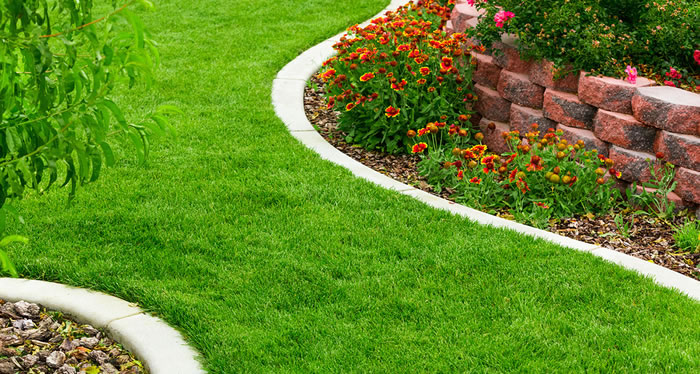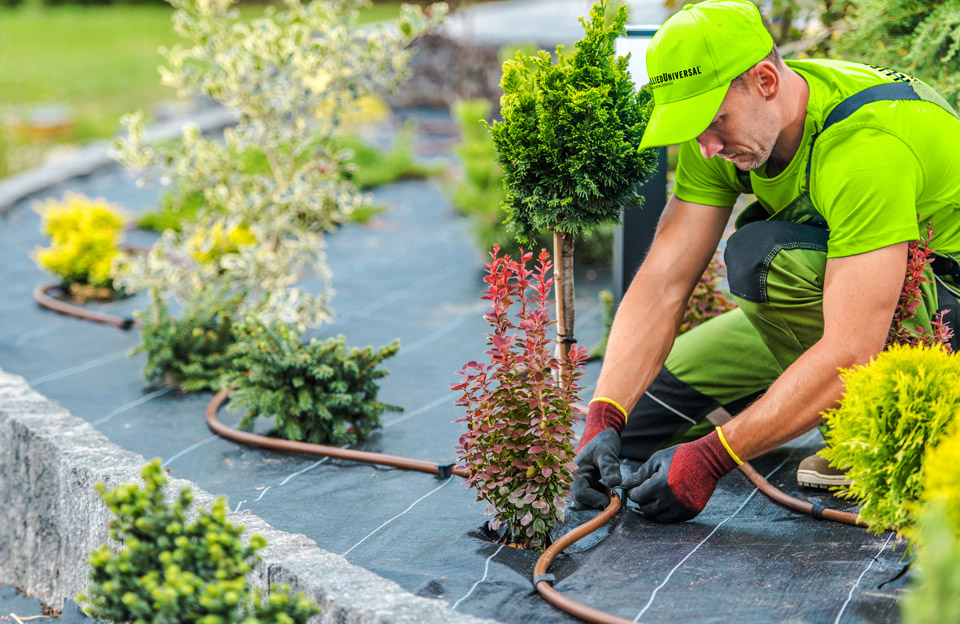Understanding the Comprehensive Range of Works in Professional Landscaping Services
The comprehensive scope of professional landscape design services incorporates a range of fundamental components - landscaping. It includes landscape design concepts, plant choice, and hardscaping features. In addition, it resolves irrigation systems and maintenance strategies. Each facet plays a critical function in creating useful and aesthetically pleasing exterior rooms. Comprehending how these parts interact can reveal much concerning the art and scientific research of landscaping. Nonetheless, the trip right into this elaborate area is just starting
Landscape Layout Principles
Efficient landscape layout principles are crucial for creating unified exterior spaces that enhance both aesthetic allure and functionality (Learn More). These principles assist the plan of elements within the landscape, making sure a natural visual experience. Secret elements include balance, which disperses aesthetic weight uniformly; proportion, which relates the size of various elements to each other and the area; and unity, which produces a sense of wholeness with consistent themes and materials

Plant Selection and Setup
In the domain of professional landscape design, plant selection and installation play a critical role in accomplishing a prospering yard. Emphasizing native plant advantages, seasonal considerations, and the certain dirt and sunshine demands of each varieties assures a lasting and aesthetically pleasing landscape. Careful planning in these areas not only improves biodiversity yet also advertises long-term ecological health.
Native Plant Advantages
Why should home owners consider native plants for their landscaping tasks? Indigenous plants offer various benefits that improve both aesthetics and environmental sustainability. They are well-adapted to neighborhood environments, calling for much less water and upkeep contrasted to non-native varieties. This strength reduces the requirement for chemical fertilizers and pesticides, advertising a much healthier community. Additionally, native plants offer habitat and food for local wildlife, including pollinators, which can enhance biodiversity in houses. Their familiarity with neighborhood soil and weather likewise results in far better development rates and longevity. By choosing native plants, homeowners not just create aesthetically appealing landscapes yet likewise contribute to ecological preservation, making a positive influence on their regional environment. Indigenous plants stand for a wise choice for landscape design projects.
Seasonal Plant Considerations
Homeowners that have accepted indigenous plants in their landscaping can further improve their outside spaces by taking into consideration seasonal plant selections. By integrating plants that grow in particular periods, they can develop dynamic and aesthetically appealing landscapes throughout the year. Spring might introduce vibrant blossoms like tulips and daffodils, while summertime can display lavish foliage and vibrant perennials. Autumn presents a combination of cozy tones with goldenrods and asters, while winter season can be emphasized with evergreens and decorative grasses for texture. Specialist landscapers commonly advise picking plants that not just complement existing native species yet also supply year-round passion and assistance neighborhood wild animals. This thoughtful approach to seasonal plant selection assures a consistently evolving and sustainable garden environment.
Soil and Sunlight Needs
Successful landscape design depends upon recognizing the details dirt and sunshine demands of plants. Various species flourish under varying conditions, calling for a mindful analysis of both variables throughout the selection process. Dirt kinds, such as sandy, clay, or fertile, influence drainage, nutrient availability, and origin advancement. In addition, pH levels can impact plant wellness, demanding soil testing to ascertain viability. Sunshine demands differ substantially; some plants prosper in complete sunlight, while others prefer complete or partial shade. A professional landscaping company takes into consideration these aspects to guarantee peak development and aesthetic appeal. By straightening plant options with the environment's certain attributes, landscapes can achieve sustainability, durability, and visual consistency, ultimately bring about successful plant establishment and long-lasting upkeep.
Hardscaping Functions and Construction

While landscape design often evokes pictures of lavish plant and vibrant flowers, hardscaping functions play a crucial duty in defining outdoor areas. These aspects, which consist of patio areas, pathways, preserving wall surfaces, and attractive stonework, provide structure and functionality to backyards and yards. Hardscaping makes use of products such as concrete, brick, wood, and rock, permitting diverse styles that match the natural landscape.
The building of hardscaping functions needs cautious preparation and execution to guarantee durability and aesthetic appeal. Professionals assess site problems, drain, and spatial connections to create natural exterior atmospheres. Proper installation strategies are critical, as they protect against concerns like erosion and shifting over time.
Including hardscaping not just boosts the visual interest of a home however also promotes outside activities, making it a fundamental element of extensive landscaping services. Inevitably, thoughtful hardscaping adds to both the capability and charm of outdoor areas.
Irrigation Equipments and Water Administration
Effective watering systems and water management are crucial parts of specialist landscaping, as they ensure that plants obtain the required hydration for ideal growth. These systems can differ from simple drip watering setups to advanced computerized sprinkler systems, made to meet the certain demands of varied landscapes. Proper water monitoring not only optimizes water use, reducing waste, however additionally improves plant health and reduces condition threats.
Landscaping experts analyze various factors, including dirt kind, plant varieties, and local climate, to develop tailored irrigation services. Furthermore, including rain harvesting strategies can further enhance sustainability and efficiency. Regular maintenance of irrigation systems is vital to keep capability and prevent leaks, which can lead to water loss and increased costs (Learn More). Inevitably, a well-designed irrigation system plays a pivotal role in maintaining the visual charm of exterior areas while advertising eco-friendly stewardship within specialist landscape design practices
Grass Treatment and Upkeep Techniques
Grass care and upkeep techniques are basic for achieving a lavish, healthy and balanced lawn that enhances the general landscape. These strategies include numerous practices intended at promoting optimal growth and aesthetic allure. Regular mowing is crucial, as it encourages thick, also development while stopping weeds from developing. Furthermore, correct fertilization offers essential nutrients, with applications tailored to the certain grass type and dirt conditions.
Watering methods ought to concentrate on deep, infrequent irrigation to motivate root development, while oygenation boosts soil structure and promotes nutrient absorption. Insect and condition management is likewise critical; identifying concerns early allows for efficient therapies that lessen damages.
Overseeding can rejuvenate broken or slim grass, boosting thickness and shade (landscaping services). By carrying out these targeted lawn care approaches, landscape design specialists can guarantee that backyards remain vibrant and healthy throughout the periods, greatly adding to the total appeal of the building
Seasonal Landscape Care and Upkeep
As the periods modification, appropriate landscape care comes to be essential here for preserving the health and wellness and charm of outside spaces. Each period provides distinct obstacles and needs. In spring, landscape professionals concentrate on pruning, growing, and feeding to encourage development. Summertime demands normal watering, weed control, and bug management to protect freshly established plants.

Throughout the year, seasonal landscape maintenance assurances that exterior locations continue to be visually appealing and healthy. Specialist services can provide tailored maintenance plans that adapt to the specific needs of each season, allowing building owners to take pleasure in vivid landscapes year-round. On the whole, seasonal treatment is an essential facet of specialist landscape design that promotes longevity and visual worth.

Sustainable Landscape Design Practices
A growing variety of homeowner are welcoming sustainable landscape design practices to develop eco-friendly outdoor spaces. These techniques concentrate on conserving sources, boosting biodiversity, and minimizing ecological influence. Native plants are usually picked for their low tide requirements and compatibility with neighborhood environments, reducing the requirement for chemical plant foods and pesticides. Rainfall yards and permeable paving are utilized to handle stormwater drainage, promoting groundwater recharge and minimizing disintegration.
Furthermore, lasting landscape design integrates natural horticulture techniques that prioritize soil wellness and advertise natural insect control. Reliable irrigation systems, such as drip watering and rainwater harvesting, aid maximize water use. Furthermore, landscape developers significantly advocate for using recycled materials, such as reclaimed wood and stones, to lessen waste. By taking on these lasting techniques, building proprietors not just add to environmental conservation however likewise develop cosmetically pleasing settings that can grow with marginal upkeep.
Often Asked Questions
How much time Does a Landscape Design Task Generally Require To Complete?
Typically, a landscape design task can take anywhere from a couple of days to a number of weeks to complete, relying on the project's complexity, dimension, and layout demands. Factors such as climate and resource accessibility also affect timelines.
What Aspects Influence the Price of Landscaping Services?
Various variables affect landscape design service expenses, consisting of task size, design complexity, worldly top quality, labor expenses, geographic area, and seasonal need. Each element contributes distinctively to the general economic needs of a landscaping project.
Are Landscaping Solutions Available Year-Round?
Landscape design services are generally offered year-round, although schedule might differ based upon area, seasonal climate condition, and certain solution offerings. Some services may be limited during severe weather or off-peak periods.
Do Landscape Design Companies Deal Service Warranties on Their Work?
Lots of landscaping business do use service warranties on their job, which can vary in length and coverage. Clients are motivated to inquire about particular terms, ensuring they understand what is assured and any kind of problems that apply.
Can I Design My Landscape Without Professional Help?
Yes, people can design their landscapes without specialist aid. Nevertheless, they may lack know-how in plant option, design, and environmental considerations, possibly bring about much less efficient designs that can need costly changes later on.
In the domain of specialist landscaping, plant option and setup play a vital duty in accomplishing a flourishing yard. Home owners that have actually accepted indigenous plants in their landscaping can better improve their exterior spaces by taking into consideration seasonal plant selections. Effective landscape design pivots on comprehending the details soil and sunshine needs of plants. Efficient watering systems and water management are crucial parts of specialist landscape design, as they ensure that plants get the needed hydration for suitable growth. Landscape design specialists examine numerous aspects, consisting of soil type, plant species, and neighborhood environment, to develop tailored irrigation remedies.